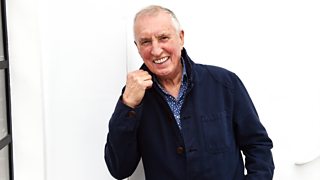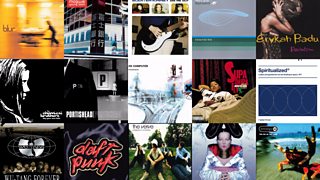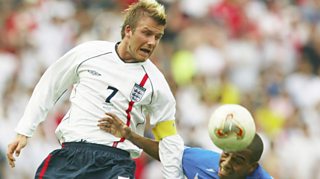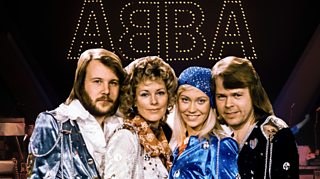The A-Z of Coldplay鈥檚 X&Y

Coldplay's landmark third album X&Y, released in June 2005, is celebrated in a new episode of Johnnie Walker's Long Players, which also takes a deep-dive into Radiohead's seminal 1997 album OK Computer.
After the success of early albums Parachutes and A Rush of Blood to the Head, X&Y saw Chris Martin and co cement their place as one of Britain's biggest bands, with the record heading straight to No.1 and going platinum nine times since.
-
![]()
Listen now to Johnnie Walker's Long Players: Radiohead and Coldplay special
Celebrating hugely influential albums from two of Britain's biggest bands.
But what led to the album’s huge popularity? We look back at the record’s development, through to its release, and what it did for Coldplay in subsequent years, as we present The A-Z of X&Y.
A is for… Awards
As well being a huge commercial hit, the album also earned Coldplay a number of awards and nominations. X&Y was named Best British Album at the 2006 BRIT Awards, while the record also saw the band collect International Album of the Year at the Juno Awards that same year.
The album was also nominated for the 2005 Mercury Prize (the band’s third consecutive nomination and last to date), while it also gained nominations for Best Rock Album at the Grammys, Best Album at the 2005 MTV Europe Music Awards, and a spot on the shortlist for Best Album at the Q Awards.
B is for… Baudot code
While the cover artwork for X&Y may look like a game of Tetris gone wrong, the coloured blocks are actually a visual representation of the Baudot code, an early mode of telegraph communication which utilises binary coding to spell out letters and words. When read through the Baudot code, the album’s cover spells out - yes, you guessed it - “X&Y”.
This theme of patterns and codes relates to the album itself, with many of Martin’s lyrics referencing puzzle-solving. On Talk, for example, he sings: "Are you lost or incomplete? Do you feel like a puzzle, you can't find your missing piece?"

C is for… Critics
Chris Martin explains in Johnnie Walker’s Long Players how X&Y was a defiant response to criticism the band had been facing at the time. “There was a period where I just felt like everybody hated what we were doing,” he says. “We were having trouble with newspapers and things like that. I thought, maybe we should stop singing about the way we feel, stop singing emotional songs and maybe start writing about characters or ironic or heavily political stuff.”
Instead of giving in to the criticism though, Martin describes how the band stuck to their guns: “We all talked about it and decided that we should edit ourselves. So the theme on the record is just anything that we have been thinking about or experiencing. I’d say the strong themes are love, loss, death, excitement, fascination with things we don’t understand and are either terrified by or inspired by.”
D is for… Delays
X&Y had originally been scheduled for release in 2004, then January 2005, but it didn’t surface until June 2005. The album’s delay made headlines at the time after causing a .
Martin later explained that the band had taken a financial hit themselves in order to release the album when it was finally ready. “Deadlines be damned,” he was as saying. “It was all to do with fiscal years and shareholders anyway. Once we forgot about the money we were free to push ourselves to the very limits and make the best album possible.”
E is for… Brian Eno
X&Y was inspired in part by the music of Brian Eno, and Eno himself plays synth on two songs from the album (The World Turned Upside Down and Talk). at the time noted: “The shadow of Brian Eno does float across the album, but it's the Brian Eno who steered U2 to arena-packing superstardom by producing The Unforgettable Fire”.
Eno ended up producing Coldplay’s follow-up to X&Y, 2008’s Viva la Vida or Death and All His Friends, with Martin explaining how tough a collaborator Eno was: "He goes: 'Your songs are too long and you're too repetitive, and you use the same tricks too much, and big things aren't necessarily good things, and you use the same sounds too much, and your lyrics are not good enough.' He broke it down."
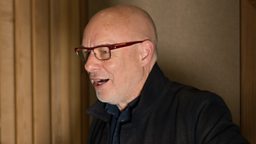
F is for… (Crazy) Frog
For “F”, we could have gone for Fix You, Coldplay’s second single from X&Y and famous for its, but then we’d be ignoring one of the strangest chart battles of all-time. Releasing the album’s lead single Speed of Sound in April 2005, Martin and co came up against a formidable - and unlikely - opponent in the form of the Crazy Frog.
Speed of Sound was released the same week that the UK was gripped by a novelty ringtone cover by a cartoon frog. Crazy Frog’s very divisive cover of Axel F (originally the theme from Beverly Hills Cop) stormed to top spot, with Speed of Sound having to settle for second place. It was Coldplay that got the last laugh, however. After follow-up Popcorn only managed a No.12 spot in the UK chart, Chris Martin fired back during his band’s Glastonbury performance of Speed of Sound that summer: “Crazy Frog, where are you now?”
G is for… Glastonbury
Speaking of Glastonbury, Coldplay have headlined the main stage at Worthy Farm a total of four times to date. They topped the Pyramid Stage line-up in 2005 just months after the release of X&Y, with a set comprising heavily of songs from their then-new album, as well as a cover of Kylie Minogue’s Can't Get You Out of My Head during their encore.
Martin even changed the lyrics to Politik from their second album A Rush of Blood to the Head to reflect the occasion, singing: "Give me weather that does no harm / Michael Eavis, Worthy Farm / Give me mud up to my knees / The best festival in history."

H is for… The Hardest Part
The Hardest Part, X&Y’s 10th track and the fourth single to be released from it, almost never made it onto the tracklist. It was left off an early version of the album that the band sent to their label, EMI subsidiary Parlophone, before the members ultimately changed their minds.
"It seemed too sunny,” Martin explained of his caution to including the track. “But then the album's called X&Y, it's about contrasts, so when we started putting it together it seemed needed. It's very necessary now."
I is for… Individually working
X&Y was recorded in multiple studios across London, Liverpool, New York and Chicago over the course of a year, with the band writing roughly 60 songs during the sessions. Guitarist Jonny Buckland describes in Johnnie Walker’s Long Players how the band’s members originally recorded their parts separately.
“We went about it in a weird way in that we never really played the songs together when we tried to record them,” Jonny explains. “We did that for about 10 months then we realised that a lot of it sounded like we had never played it together. It had no atmosphere or tension in it.”
“It just sounded flat because we were working individually,” bassist Guy Berryman adds, stating that the band soon realised things needed to change. “It came to the point where we realised we weren’t working as a band anymore and it could have just been session musicians. What we had to do was find ourselves again as a band and go back to basics. That’s when things really started to happen.”
J is for… Johnny Cash
'Til Kingdom Come, a hidden track on the album, was originally written with Johnny Cash. A few years prior to X&Y’s release, Martin had been in the studio with legendary producer Rick Rubin, who was looking for material for the country legend’s next album. Sadly, Cash passed away in 2003, before he was able to put his unique slant on the track.
Guitarist Jonny Buckland explained to Yahoo! in 2006: “It was written for Johnny Cash, for him to play. Chris actually recorded it with Rick Rubin, ready for Johnny to sing over. But unfortunately, he never had a chance, because he died. And so we recorded it, 'cause we really liked it. We recorded it and put it on the album as a secret track. That was basically it, our tribute to Johnny Cash.”
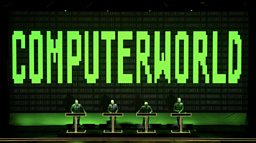
K is for… Kraftwerk
Talk, the third single from X&Y, features an interpolation of Kraftwerk’s 1981 single Computer Love. With the German electronic icons , Martin has explained that he resorted to sending Kraftwerk a letter in rudimentary German requesting permission to incorporate a motif from their song.
“The only thing I could think of was the pen pal letters I learnt in German lessons at school,” Martin at the time of release. “I had no idea if they knew who Coldplay were so had to explain myself like a 15 year-old school-boy. ‘Dear Ralf, I sing in a band called Coldplay, blah, blah.’ I drew a little picture. Everyone says it's extraordinary that they said yes.”
L is for… Low
Low, X&Y’s ninth track, may not be the most well-known song from the album, but Martin has described it as a “turning point” in the record’s creation.
He explained to Q Magazine in 2005: "We had this piece we'd written on tour in Zurich and I'd listened to it on my computer and think, ‘that's a great thing’. And then I was in San Diego, and just as I was leaving the hotel, I had this idea, so I went to the lobby piano and worked out these chords. And then we booked ourselves into a tiny rehearsal space and we all got such a buzz from playing that it made us realise we had gone wrong on the recordings of all the other songs. I realised last August that I was missing everyone else and Low was what brought us back together."
M is for… Michael Stipe
As well as taking inspiration from the likes of Kraftwerk, Brian Eno and David Bowie for X&Y, one of its track was intended as an “ode” to R.E.M. Martin that The Hardest Part was a tribute to frontman Michael Stipe and Coldplay’s own version of Losing My Religion.
"I've lost all respect for fame, but I haven't lost all respect for respect,” Martin said. “So the one great thing about being famous is that I get to meet people who I respect.” He described his relationship to Stipe was being “akin to a dog and its master”, adding: “I'll always look up to him."
Coldplay went on to perform R.E.M.'s "Nightswimming" with Stipe himself during their 2005 Austin City Limits performance, as well as a cover of Joseph Arthur’s In the Sun.

N is for… Nelson, Ken
X&Y marked the last album that Coldplay worked on with Ken Nelson, who had produced their previous two albums (Parachutes and A Rush of Blood to the Head). Liverpool-based producer Nelson had worked on Gomez's Bring It On and Badly Drawn Boy's The Hour of Bewilderbeast, both Mercury Prize winning albums. Despite originally being brought on board again to produce X&Y, the band later decided to work with producer Danton Supple after expressing dissatisfaction with their early sessions.
Nelson worked on four songs that would make it onto X&Y (White Shadows, Fix You, Twisted Logic and 'Til Kingdom Come) and would go on to produce Feeder's Pushing the Senses and Paolo Nutini’s These Streets, among other records.
O is for… Number One
As previously noted, X&Y topped the charts on both sides of the Atlantic, also reaching No.1 in France, Germany, Italy, Ireland, Canada, Australia and many other countries. It was also the .
According to figures from the International Federation of the Phonographic Industry (IFPI), X&Y sold 8.3 million copies worldwide in 2005, beating Mariah Carey’s The Emancipation of Mimi (7.7 million) and 50 Cent's The Massacre (7.5 million) to top the global year-end list.
P is for… Paltrow
In Johnnie Walker’s Long Players, guitarist Jonny Buckland explains how Fix You was “the one song that we built the album around.” The song was actually penned for Martin’s then-wife Gwyneth Paltrow, who had been mourning the death of her father Bruce.
Paltrow’s mother Blythe revealed in 2012: “[Martin] wrote the song Fix You for Gwyneth when her father died and I weep every time I hear it... I think he met Gwyneth about a week after Bruce died. He would have loved him.”
Martin has also spoken about how Bruce had influenced the album’s sound, telling USA Today: "My father-in-law Bruce Paltrow bought this big keyboard just before he died. No one had ever plugged it in. I plugged it in, and there was this incredible sound I'd never heard before. All these songs poured out from this one sound.”
Q is for… The Queen
While recording X&Y, Coldplay were invited to meet The Queen, ultimately turning down the offer. An from the time provides the details: “During a break from recording, an assistant has tracked down Chris Martin at the Notting Hill studio where Coldplay are wrapping up their third album. There are some things to go over. ‘The Queen has invited you to a tea at Bucky Palace,’ she cheerfully informs him. Martin is intrigued, momentarily. ‘We do live in the neighborhood,’ he figures.”
Martin ultimately decided against it, though. “I don’t think we should go,” he is quoted as saying. “As much as I like the Queen. We’ve got three more years of rebellion in us.”

R is for… Running Up That Hill
The album’s lead single, Speed of Sound, was inspired by a Kate Bush song, with Chris Martin in 2005: "We were listening to a lot of Kate Bush last summer, and we wanted a song which had a lot of tom-toms in it. I just had my daughter also, and was kind of feeling in a sense of awe and wonderment, so the song is kind of a Kate Bush song about miracles."
Bassist Guy Berryman later named the Bush song in question to be Running Up That Hill, : "We were really trying to recreate the drums on that song for this song, and the chords. Some bands are reluctant to admit that they take things from other artists and bands that they listen to and we're shameless in that respect, we don't mind telling."
S is for… Steve Jobs
Late Apple founder Steve Jobs was a known Coldplay fan, having been . When he passed away in 2011, the group issued a in tribute, writing: “We are so sad to hear about the passing of Steve Jobs. In all of our encounters with him he was such a lovely man, and always so humble about his incredible talents. Like all of the people he knew, and the millions of others he didn’t, we will miss him.”
Coldplay went on to perform at a memorial event held at the Apple headquarters in Cupertino, California on 19 October 2011, playing a four-song set that included X&Y’s Fix You.
T is for… Twisted Logic Tour
On the back of X&Y, Coldplay embarked on the Twisted Logic Tour, which stretched from April 2005 to March 2007. The stint comprised of over 130 shows throughout Europe, North America, Asia, Australia and South America and included festival appearances at Glastonbury, Isle of Wight Festival, Coachella in California and Austin City Limits in Texas.
The band’s live show for the tour included balloons, glitter, fireworks and an impressive light show, while the Twisted Logic Tour remains the band’s only tour to date not to be named after one of the band’s album, instead taking its name from the title of X&Y’s penultimate track. Interestingly, the song Twisted Logic was never actually performed on the Twisted Logic Tour.
U is for… U2
Many reviews of X&Y noted its U2 influence and, during Johnnie Walker’s Long Players, journalist David Hepworth remarks on the similarities: “People talk about [Coldplay’s] resemblance to U2 and I think the resemblance is that great sense of suspense and release. Things start throbbing away and you know at some point they’re going to burst forth.”
He adds of Coldplay: “They burst forth with lyrics that people can identify with… listeners [take the lyrics] to themselves and identify with the emotions expressed. That’s probably what’s made them as success as they’ve been.”

V is for… Viva la Vida
Viva la Vida or Death and All His Friends, Coldplay’s 2008 follow-up to X&Y, was actually partly a response to criticism their previous album had faced from some quarters of the press. Speaking in 2008, Martin said that he had felt “liberated” by the negative reviews.
Martin told Rolling Stone of his reaction to a New York Times critique of X&Y: "It was a big deal. It's the first real attack on your band, and from a publication we all respect… I agreed with a lot of the points... so, in a way, it was liberating to see that someone else realised that also. And there is something glamorous to me in taking a bit of a beating and keeping on going."
W is for… What If
In a clip aired during the show, drummer Will Champion cites the album’s second track, What If, as being one of “three songs that were the bedrock and foundation to the record, the anchor to which everything else happened” (alongside Fix You and Swallowed In the Sea).
Speaking to Q Magazine in 2005, Champion described the song as “lyrically... the best Chris has ever written”, adding: “It sounds really pompous, but you know how [John Lennon’s] Imagine talks about how what if everything was great? This is the flipside to that: if everything's s**t, what would you do?"
X and Y are for… X and Y
X&Y stands as the band’s first venture into concept album territory, with the record split between two parts: X and Y. The first, Side X, consists of six songs (Square One, What If, White Shadows, Fix You, Talk and X&Y), while Side Y includes seven tracks (Speed of Sound, A Message, Low, The Hardest Part, Swallowed in the Sea, Twisted Logic, 'Til Kingdom Come).
A of the album at the time noted of its two halves: “X is filled with unanswered questions and childlike pondering, whereas Y is more of a sorrowful explanation and lamented reality of the truth”.
Martin, meanwhile, explained: “X and Y is the mathematical formula used when you don’t know the answer. But, it’s also like black and white, or hope and despair, or optimism and pessimism. Everywhere you look there’s a tension of opposites.”
Z is for… Zero
Finally, zeroes tie into the album in multiple ways. Not only can they be linked to the Baudot code-inspired artwork (binary conversations of the Baudot code would use zeros and ones), but fans often referred to X&Y as “Zero Theory” (thought to be a working title for the album) prior to the record’s release.
-
![]()
Radiohead鈥檚 OK Computer and 14 more albums that define 1997
The 6 Music team celebrate some of 1997鈥檚 finest albums, including OK Computer.
Follow us on Instagram at , and Tik Tok .
Listen to Radio 2 on 成人快手 Sounds, or find out other ways you can listen.
